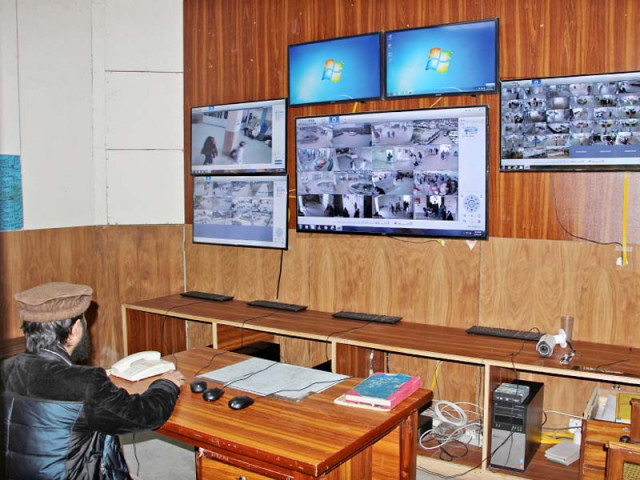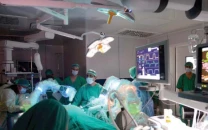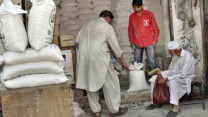Computerised records make life easier for patients at ATH
Record of patients including registration, admission, discharge integrated into the system

A hospital official monitors the CCTV operation. PHOTO: EXPRESS
Within are reports for his blood test.
What takes him by surprise is not what is contained in the report, rather, that he did not have to make repeated trips to laboratory to submit samples and then retrieve the report.
The change is the result of a new computerised Hospital Information Management System (HIMS) installed at the Abbottabad Teaching Hospital (ATH).
The system, worth Rs20 million, was donated by the Shaukat Khanum Memorial Hospital to health facilities in Khyber-Pakhtunkhwa last month. But ATH is the first public sector facility to implement and make the system operational in the province thus far.
Being only tertiary care hospital for seven districts of Hazara division, the hospital treats around 30,000 emergency patients every month. The ATH is 1,300-bed hospital with around 1,500 to 1,800 patients visiting its OPDs daily.
Shafiq Rehman, the media coordinator for ATH, said that the system consists of three modules, bringing about drastic changes in the clinical, financial and administrative system of the hospital. He added that the new system would help reduce the hospital’s dependence on error-prone manual system currently in vogue elsewhere and help tackle the litany of complaints patients have about hospital workings.
Hospital Director Brigadier (retired) Ajmal Khan said that with the new computerised system, all medical records of patients would be available in all the wards, laboratories and pharmacies at the click of a button.
During the first phase of implementing the new HIMS, he said records relating to patients’ including registration, admission and discharge have been integrated into the system together with the pathology department.
In the second phase, which is likely to begin next month, the medicines, radiology and patient management departments would be integrated into the system. Once that is complete, patients would not need to carry their bundle of prescriptions and medical records since doctors in 16 departments of the hospital could access them after entering the patient’s unique registration number.
Brig Ajmal hoped that going forward the system would also help control embezzlement, mismanagement and wrongdoing in the capital.
However, the system would not only benefit patients. ATH Cardiologist Dr Mattiullah said that HIMS would also help physicians design treatment plans and procedures for patients since their entire treatment records would be immediately available.
Dr Kaleem Ahmed, a pathologist at the ATH, said that previously hospital staff and attendants would collect blood samples from the wards and drop them off at the Pathology Labs. In this manual system, there were frequent complaints about delays and change of result. However, owing to the new computerised system, all machines in the pathology department such as the Selectra, chemistry and haematology analysers were now integrated into the system and reports are properly documented and made available to patients in their respective wards.
Naveeda Bibi, a school teacher who was tending to a patient from Mansehra, told The Express Tribune that she too had felt some improvement in the hospital’s system after computerisation of records.
She stressed on the need of implementing the system with proper monitoring otherwise the chances of wasting energies and efforts could not be ruled out – similar to the poor results of employing biometric attendance system for schools.
One CNIC to connect
Explaining the workings of the new system, HIMS in charge Engineer Shehryar Ali told The Express Tribune that a patient’s computerised identity card number is entered into the system which forms the basis of his individual medical record (MR) in the system. His records can then be recalled in the system by entering that CNIC number.
He added that the HIS is not just limited to tackling patient treatment records. Rather it consists of four modules including clinical, financial and administrative.
He said that before the system was introduced, a patient would have to first stand in long queues for around half an hour, sometimes even more, to get a number chit. The patient would then wait for his turn to be examined by the doctor.
“But now, we have established computerised counters for each of the department’s OPD enabling the patients to face little hassle of waiting in queues. “
Hospital records
Apart from patients Tariq Mehmood, an official at the human resource department of the hospital, said that the new system has helped him computerise employment records of the nearly 2,000 people who work for the hospital.
He further claimed that the financial system has also improved with the computerisation of the payroll and hospital receipts.
Published in The Express Tribune, February 25th, 2017.



















COMMENTS
Comments are moderated and generally will be posted if they are on-topic and not abusive.
For more information, please see our Comments FAQ